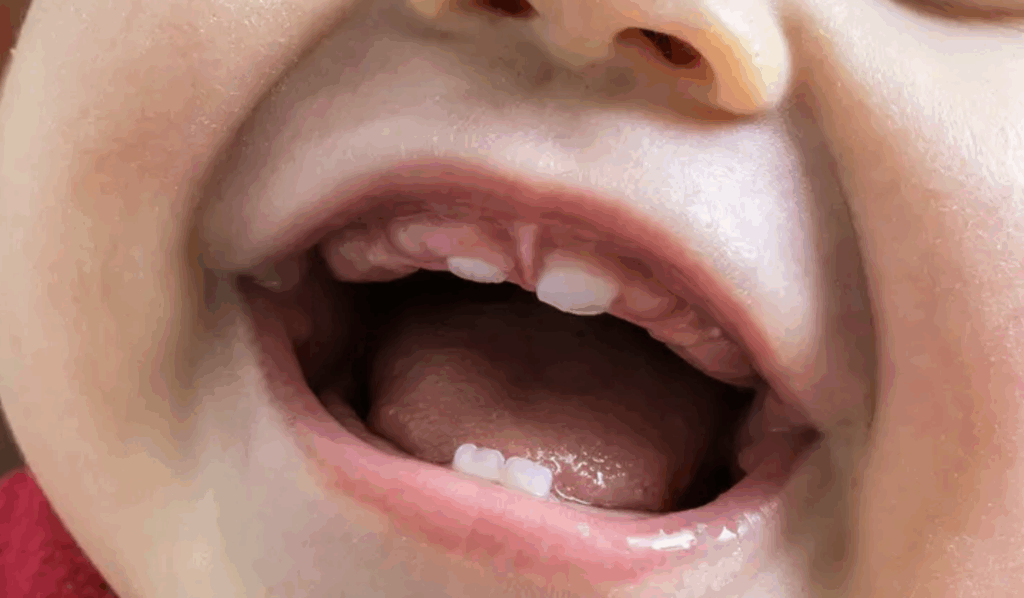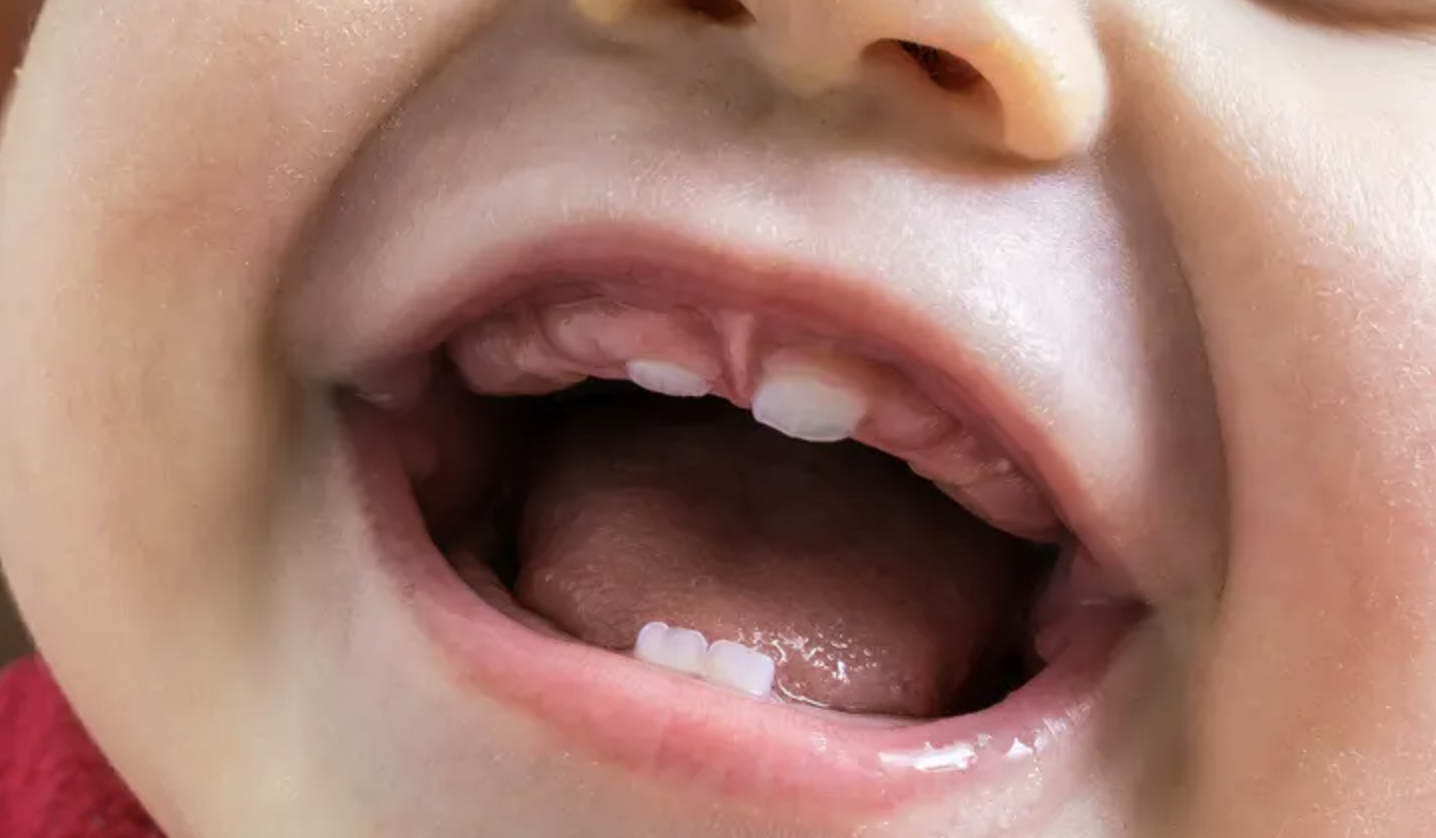What Is a Lip Tie?
Written for Medical Realities by Meghan Gessner on August 27, 2025
Your upper lip is tethered to your gums by a thin strip of tissue called the lip frenulum (maxillary labial frenulum). When that band is extra short or tight, the upper lip can’t move freely—that’s what folks mean by an upper lip tie. In babies, a true lip tie in babies can sometimes mess with latch, but not every visible band needs fixing.
Lip Frenulum vs. Lip Tie
Everyone has a lip frenulum—totally normal anatomy. A lip tie is when that tissue restricts movement enough to cause symptoms. The frenulum shifts as kids grow and teeth erupt, so a “thick band” today might look different in a few months. Diagnosis focuses on function (can the lip flange and move?) more than looks. If you’re Googling what is a lip tie, think function first.
Types of Upper Lip Attachments
- Mucosal: Attaches high, near the mucogingival junction (top of the gums).
- Gingival: Anchors lower onto the gum tissue itself.
- Papillary: Inserts between the front teeth (interdental papilla).
- Papilla-penetrating: Extends between the teeth, crosses bone, and reaches toward the palate.
Understanding Lip Ties
Here’s the honest tea: calling something a “lip tie” can be controversial. Lots of babies have a prominent frenulum and do just fine. A true tie limits lip lift or flanging and may contribute to latch or seal issues. Evidence clearly supports treating certain tongue ties; the data on lip tie treatment is mixed. Some studies link tight bands to latch problems or reflux from poor seal; others don’t. Decisions are case-by-case—based on feeding history, exam, and response to lactation support.
Signs and Symptoms of a Lip Tie
- Upper lip doesn’t flange (flip out) during latch; limited mobility.
- Clicking sounds, milk leaking, or lots of air intake while feeding.
- Gassy baby, fussiness at the breast/bottle, slow weight gain.
- Sore nipples for the nursing parent despite good positioning help.
- Later on: a gap between the top front teeth (midline diastema) or tricky brushing along the gumline.
Remember, these are lip tie symptoms to discuss with your pediatrician, lactation consultant, pediatric dentist, or ENT. Many feeding issues improve with positioning tweaks and latch coaching before considering any lip tie revision.
What Causes a Lip Tie?
Some variation is just how humans are built. Rarely, tighter or unusual attachments show up alongside genetic conditions that affect connective tissue, muscle, or craniofacial development (for example, Ehlers-Danlos syndrome or other syndromes your specialist might screen for). For most families, there isn’t a single known cause—and plenty of prominent frenula never cause trouble.
When to Ask About Treatment
If feeding struggles persist after skilled lactation help—or if dental spacing, hygiene, or speech concerns pop up later—your team may talk options. Approaches range from watchful waiting and stretching/massage to procedures (scissors or laser) in select cases. Share a clear history, bring feeding videos, and ask about risks, benefits, and expected outcomes for your child’s age.
Signs and Symptoms of a Lip Tie
If you’re wondering about an upper lip tie in your baby, the big red flag is a tight, low-attaching band that keeps the upper lip from flipping out (flanging). Other classic lip tie symptoms in little ones can include:
- Slow or choppy weight gain
- Reflux or extra gassiness from swallowing air
- Fussiness at the breast or bottle
- Extra-long, tiring feeds or quick “snack” feeds
- Clicking/smacking sounds during feeding
- Milk leaking from the corners of the mouth
Nursing parents may notice nipple pain during or after feeds, cracked nipples, or engorgement/clogged ducts because baby can’t keep a solid seal.
In older kids and adults, a stiff or low-inserting band can show up as:
- A gap between the top front teeth (midline diastema)
- Loss of gum tissue between teeth or receding gums
- Harder-to-clean gumline; brushing feels awkward or tender
- More cavities along the upper front teeth
- Bite or spacing issues that nudge teeth out of line
Diagnosing a Lip Tie
For babies, your pediatric clinician will examine the upper lip, check how freely it lifts, and often watch a live feed or video to see latch, seal, and transfer. Function beats looks—if the lip can’t flange and feeding is struggling, that supports a diagnosis of lip tie in babies.
For bigger kids and adults, a dentist or orthodontist may spot it during a routine exam by gently lifting the band and looking for blanching of the papilla (that gum tissue between the front teeth) or restricted lip mobility.
Lip Tie Revision
Whether to treat is individualized. Some families see feeding improve with positioning help and lactation support alone; others discuss lip tie treatment. Evidence is strong for tongue-tie release; data for lip-tie release is mixed, and many frenula loosen as kids grow.
When the attachment is truly restrictive—especially if it extends between the teeth toward the palate—your provider may suggest a lip tie revision (frenectomy). That can be done with scissors or laser; sometimes a few stitches are placed. Ask about risks, healing time, and what changes to expect.
If you’re researching next steps, useful terms include upper lip tie, lip tie symptoms, lip tie in babies, lip tie treatment, and lip tie revision, and bring feeding notes or videos to your consult so your team can tailor the plan.

What Is a Lip Tie?
An upper lip tie is when the small band of tissue under the top lip (the labial frenulum) is short, tight, or attaches low on the gums, limiting how far the lip can lift. In babies, that restriction can make a deep latch tough and turn feeding into a struggle.
What Causes a Lip Tie?
There’s no single proven cause. Some providers see a family pattern—if you had a tight frenulum, your child might, too—but the “why” is still unclear. Bottom line: some frenula are totally normal, others are restrictive enough to create lip tie symptoms.
How Are Lip Ties Diagnosed?
If you suspect a lip tie in babies, loop in a pro: your pediatric clinician, a lactation consultant, or a pediatric dentist who sees ties often. Expect a mouth exam plus a feeding check—providers look for a lip that won’t flange, a shallow latch, clicking, milk leaking, long or very frequent feeds, slow weight gain, or jaundice from poor transfer.
Under the lip, the attachment is also graded by where it lands:
- Level 1 – Mucosal: attaches at the gumline’s top border
- Level 2 – Gingival: inserts lower into the gums
- Level 3 – Papillary: reaches between the front teeth
- Level 4 – Papilla penetrating: passes between teeth and onto the palate
How Does a Lip Tie Affect Breastfeeding?
Breastfeeding is natural, not automatic. A tight lip can block a deep latch, so parents may feel sharp nipple pain, see lipstick-shaped nipples after feeds, or deal with engorgement, clogged ducts, mastitis, and milk-supply swings. Babies may click, choke or spit milk, “cluster feed” but still seem hungry, and gain weight slowly.
Lip Tie Problems Later in Life
Not every tie causes trouble, but a truly restrictive one can:
- Trap milk/food and raise cavity risk along the upper front teeth
- Cause gum recession or irritation where the band tugs
- Create a gap between the front teeth (midline diastema), especially with Level 3–4 ties
- Make early spoon-feeding messy (lip doesn’t sweep food) or shape “picky” mechanics around eating
Lip Tie Procedure (Frenectomy) & Aftercare
When conservative help (positioning, latch work) isn’t enough, families discuss lip tie treatment. Evidence for tongue-tie release is strong; for lip ties it’s mixed, so decisions are individualized. If function is clearly limited—particularly with Level 3–4—your provider may recommend a frenectomy, often done with scissors or a small laser in the dental office.
What it’s like: baby is gently swaddled or secured, the area is numbed, and the tight band is released. The visit is quick, and many babies nurse right away; others need a little time and guidance to relearn a deeper latch. To reduce reattachment, your team will teach simple stretches (lifting the lip and lightly rubbing the site with a clean finger) several times a day while it heals.
Helpful Terms for Your Search
When you’re digging deeper or prepping for a consult, these phrases can help: upper lip tie, lip tie symptoms, lip tie in babies, lip tie treatment, lip tie revision, and frenectomy. Bring feeding notes or short videos—real-world clips make care plans faster and more precise.










